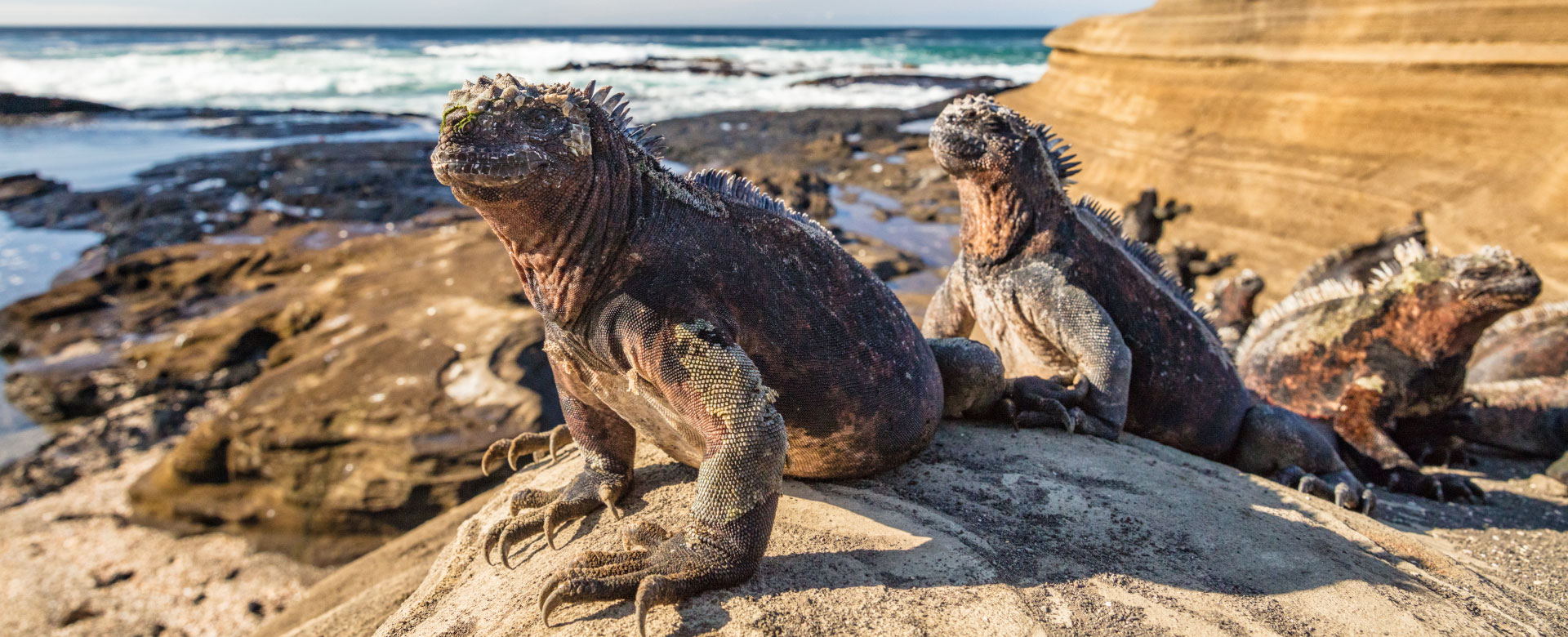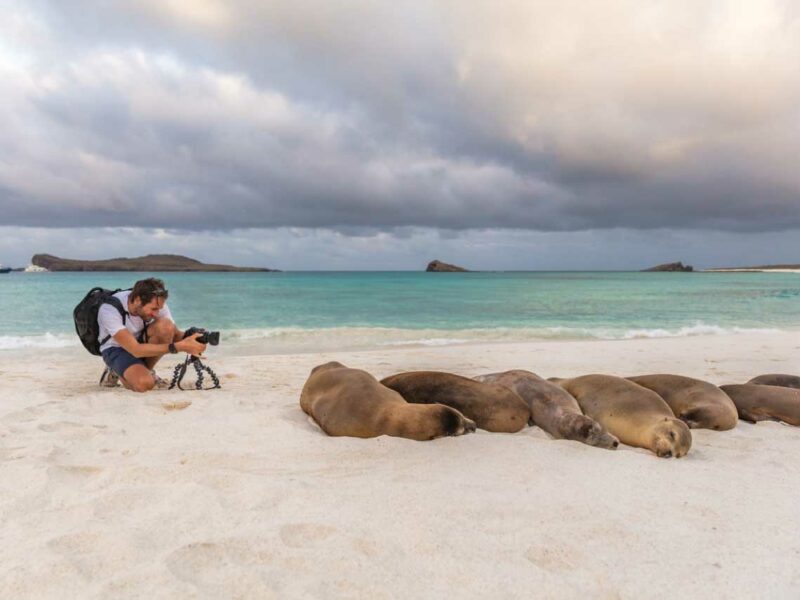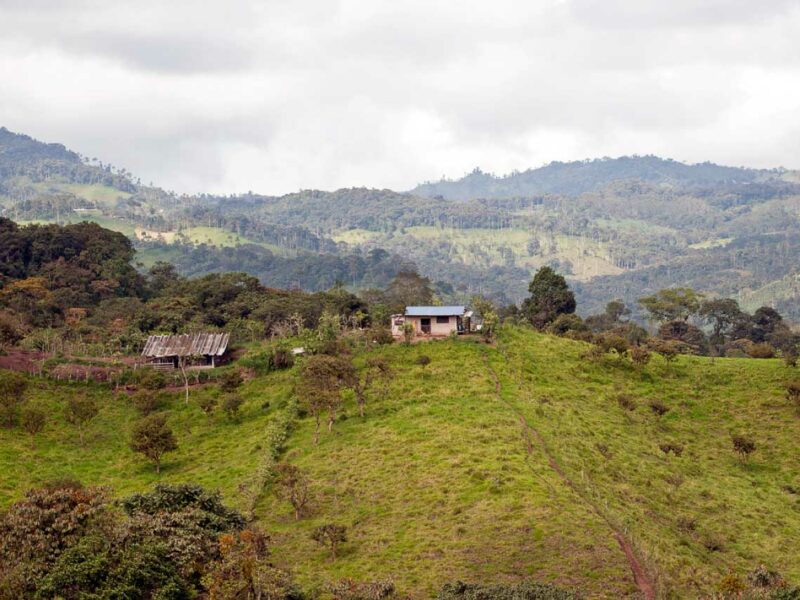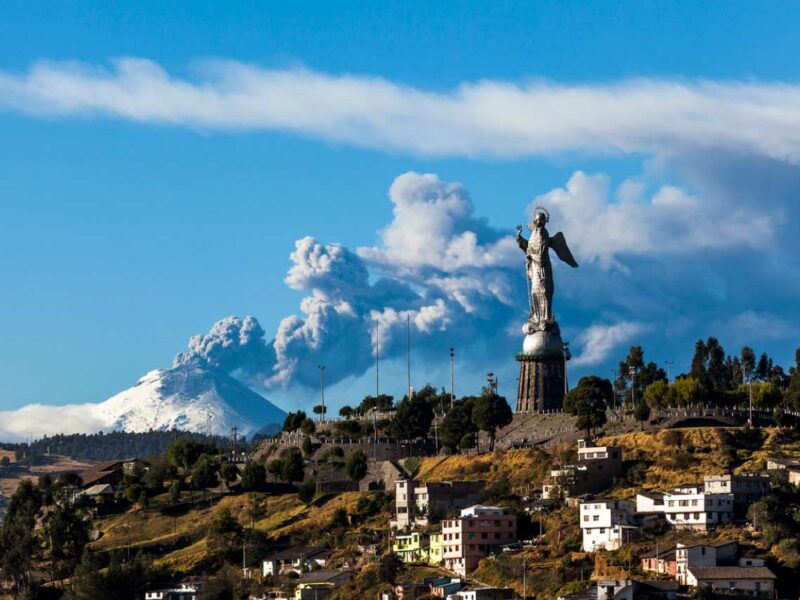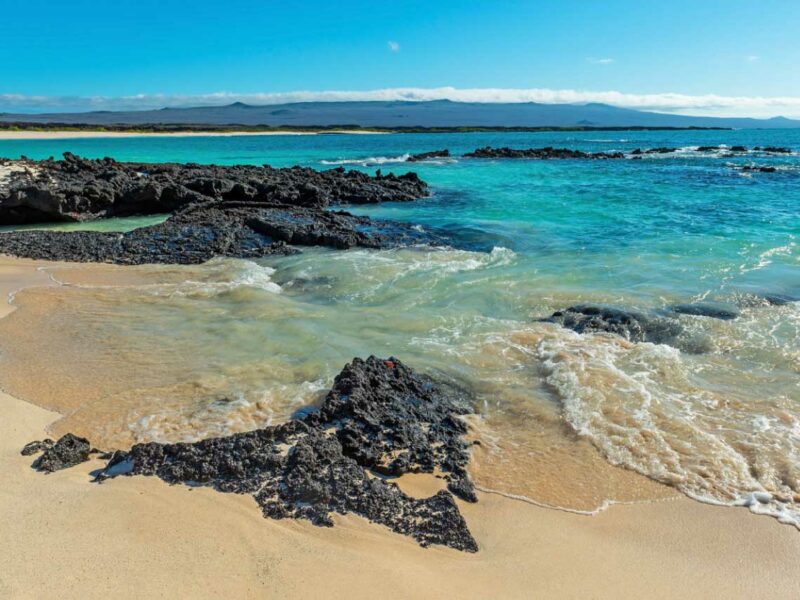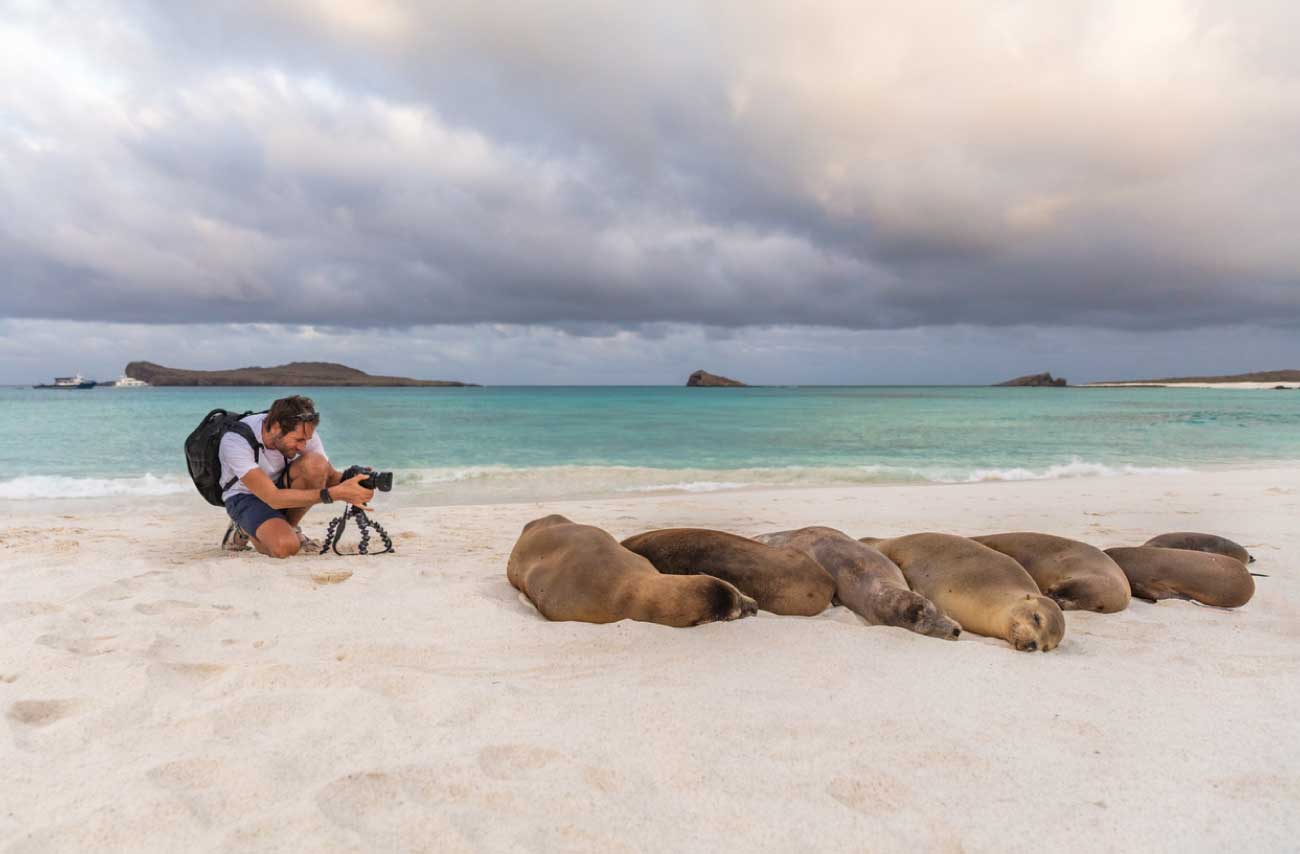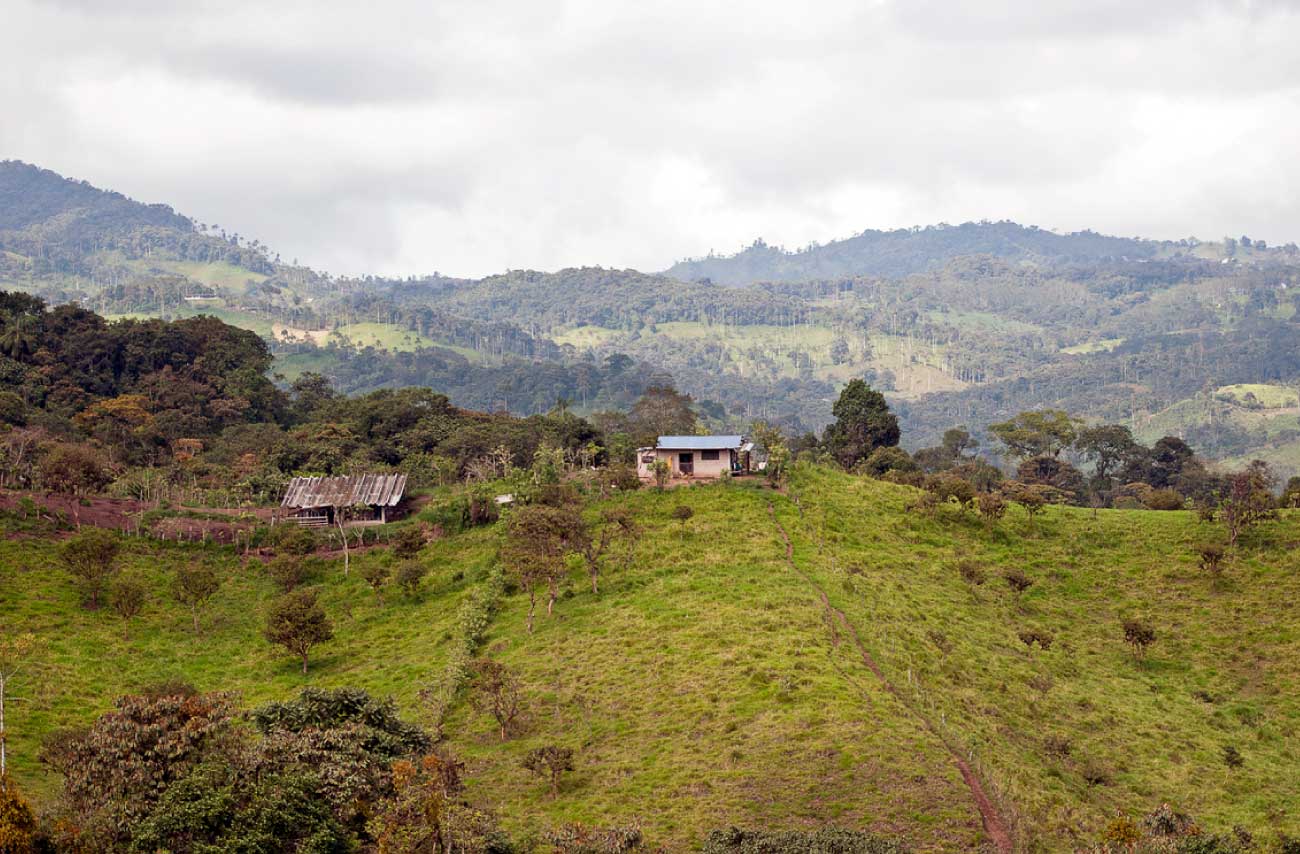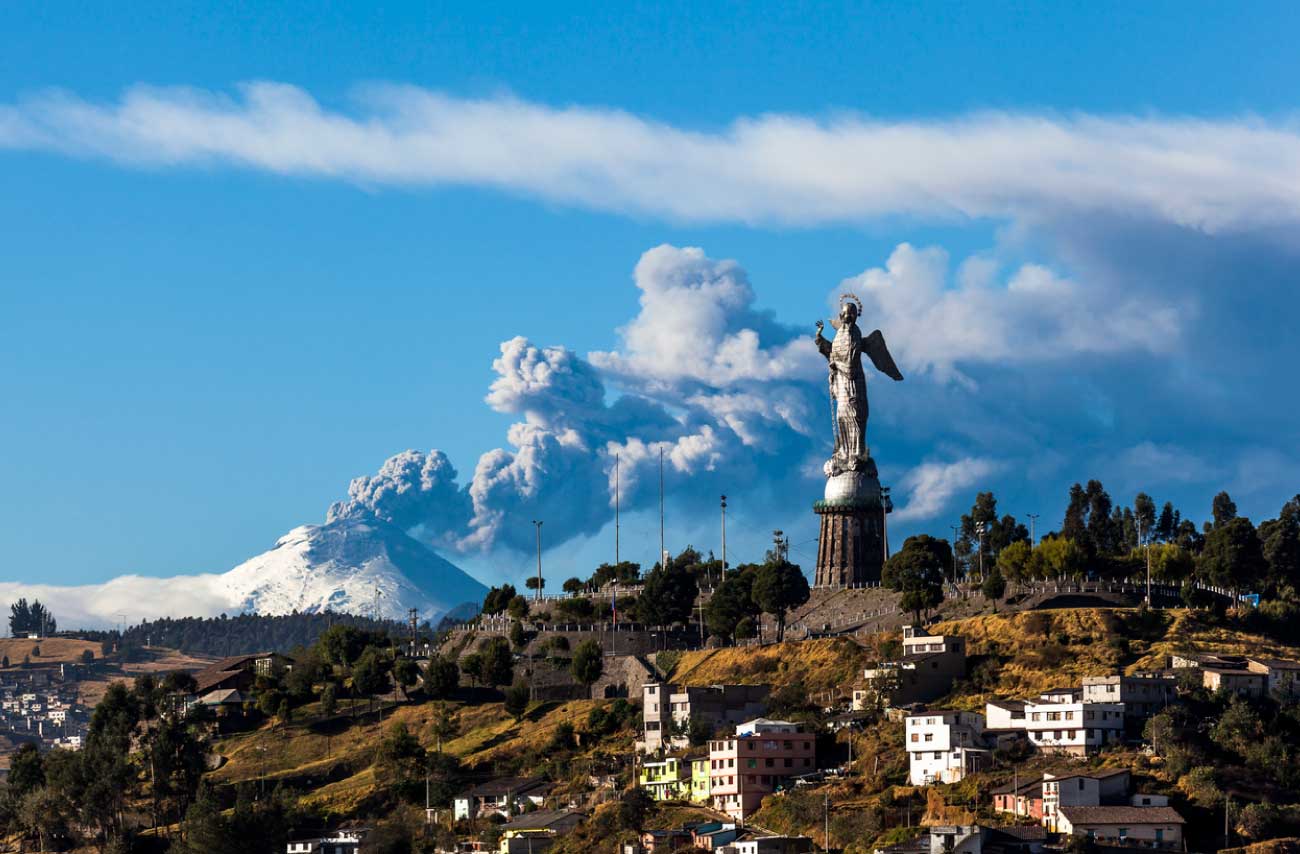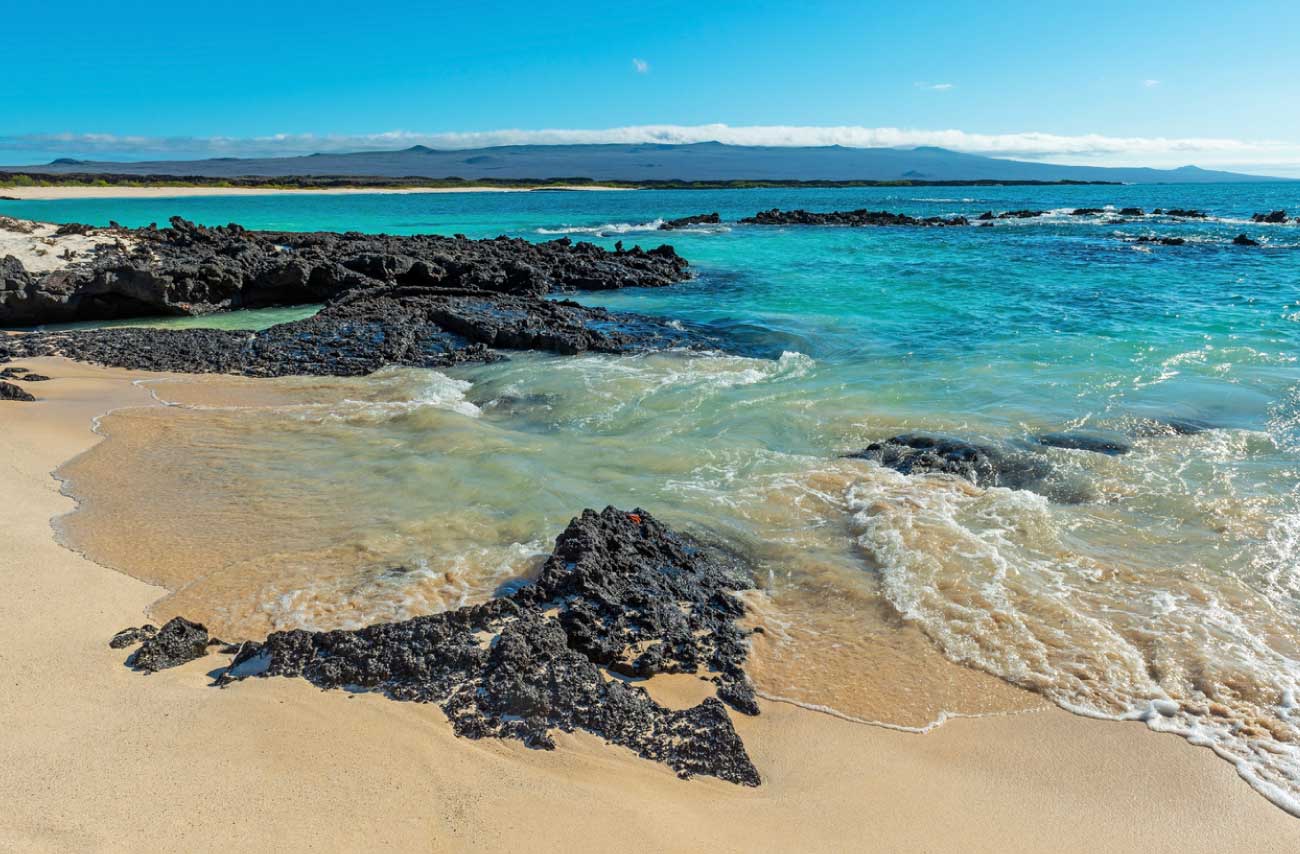Quito & Eastern Islands Cruise ( Tacht La Pinta )
per person
-
Destination
-
Dress Code
Casual. Comfortable athletic clothing, hiking shoes, hat, light jacket.
1
Day 1 - Quito
Quito Transfers in/out - airport/hotel or viceversa
Welcome to Quito and Ecuador!. At the airport you will be greeted by a member of our organization, we will escort you all the way to your hotel, giving you a short briefing about Quito and the country in general with valuable information you need to know. Enjoy scenic colonial and artistic Quito, visit museums, monasteries and the golden altars of its many churches. Stand with a foot on each hemisphere on the Middle of the World memorial. The capital of Ecuador has a setting that few cities in the world can match. During the 13th century it was the prosperous center of the Kingdom of Quitus. It later became the northern capital of the Inca Empire. In the 16th and 17th centuries, Colonial architects built formidable temples, monasteries and mansions, creating an urban jewel designated by UNESCO/UN as a World Cultural Heritage Site. Quitos artistic creativity awaits the visitor in cosmopolitan galleries and boutiques filled with contemporary paintings, sculptures and exquisite traditional crafts.
On Arrival to Ecuador (Mariscal Sucre International Airport), once you have passed through customs and immigrations you will collect your luggage and proceed to the arrival hall. There you will meet our guide and take you to your Hotel. Baggage handling of two pieces of luggage per person at airport and at hotel is included.
Accommodation: Hotel Sheraton Quito
2
Day 2 - Quito
Quito and the Center of the World monument (shared)
We visit downtown Quito to relish in this urban jewel and its treasures of art and architecture. Quitos colonial quarter, the largest and best preserved of South America, is a UNESCO World Heritage Site. We will stroll at the Independence Plaza, flanked by the Cathedral, the Presidential Palace, the Municipal Building and the Archbishop's Palace. We will visit also the temple of *La Compañía de Jesús and its awesome gilded interior. We continue on to the Monastery of San Francisco, one the of great religious buildings of the New World; its impressive façade and atrium that lead to its Baroque interior influenced by Moorish style, with the winged Virgin of Quito at its main altar.
Then we will continue to the Equatorial Monument, 25 Kms. (16 miles) North of Quito, which marks the exact Middle of the World, latitude 0º, where we can stand with a foot on each hemisphere. We will visit the Ethnographic Museum inside the monument, which shows the different Native American groups living in Ecuador. Beside the monument there is a colonial-style town, complete with main square, church, post office, bullring, cafeterias, restaurants and many gift shops with postcards and souvenirs. A certificate for having crossed the Equator will be given at the end of our tour.
Accommodation: Hotel Sheraton Quito
Included Meals: B
3
Day 3 – Quito / Mashpi
Only Transportation from Sheraton to Departure Point
The adventure begins in Ecuador’s heritage capital, Quito, at our 8 AM pick-up time for guests staying in Quito’s main hotels (departure points)
Mashpi Lodge is located three hours by car from Quito (110 Km, 70 miles) in the evergreen wilds of the Andes’ western slope. The sudden shift in altitude (from 2800 msnm to 1000 msnm) will allow us to discover the spectacular natural diversity of the Andean landscape as we travel through the dry valley of Pomasqui towards the cordillera’s western flank, into lush, misty cloud forest, and finally reach Mashpi, a nature sanctuary located in the spectacular Chocó, one of the most celebrated bioregions in the world, known for its record-high endemism, rainfall and altitudinal range. We first stop at Pululahua Crater and its lookout point, where we can marvel at the unique scenic beauty of a collapsed volcano where people live and farm, taking advantage of the fertile volcanic soil. On our way to Mashpi, we visit the archaeological ruins at Tulipe, said to have belonged to the ancient Yumbo civilization of pre-Inca Quito, set in a magical forested location. We’ll taste delicious Ecuadorian appetizers and fresh-brewed coffee prepared by members of the local community before our final one-hour descent into Mashpi Reserve.
Around 12:30 PM, we are received at the Hummingbird Station. Mashpi boasts a total 32 hummingbird species identified to date, many of which inhabit different altitudinal ranges, with around 19 species considered common at our specially designed feeder station. Not only will we observe hummingbirds of all kinds, but also toucans, tanagers, squirrels, and more. The site is located at a natural viewpoint, which, on clear days, provides breathtaking views of the reserve's forested hills. This is a veritable photographer’s paradise, regardless of your level of experience.
After settling into our respective rooms, we are introduced to our naturalist guides who will briefly speak about the cloud forest and its conservation, the activities you will be offered during your stay, and helpful tips about what to wear and bring to the excursions. This will take place before lunch at our library (lasts around 30 minutes).
The trail is named after the Cucharillo Tree (Magnolia dixonii), which in Spanish means ‘little spoon’, an Ecuadorian endemic that is common at Mashpi, although otherwise threatened throughout the country. The trail requires some physical condition due to its steeper portions, but has been made less demanding thanks to recycled plastic crates that have been used to form steps and make paths firmer. At the end of the trail find a large waterfall and rocky riverbed with beautiful ponds and smaller waterfalls. The excursion takes about 2 hours to complete.
The forest transforms by sunset: the sounds and smells intensify and other senses are awakened. We will discover the evening croaking of nocturnal frogs and incessant buzz of insects. If we turn off our flashlights, we will be able to observe sparkling fireflies and feel bats zipping by. On the ground, we’ll discover the faint glow of bioluminescent fungi all around. And as we turn our flashlights on again, we’ll quickly notice the reflection of hundreds of tiny insects. As we continue on, owls and other nocturnal birds may call into the night, while the rustling of branches above us may mean that we’re in the presence of kinkajous (Potos flavus), an arboreal mammal relative to the raccoon, making their way through the trees in search of ripe fruit. The excursion begins at 7 PM and takes about 45 min to an hour. We then return to the lodge to enjoy a delicious dinner.
Accommodation: Mashpi Lodge
Included Meals: BLD
4
Day 4 - Mashpi
The forest always rewards the “early birds”, as the dawn light lures a variety of fascinating species in their search for food. A good place to find birds is actually right at the hotel’s terrace, with a cup of fresh coffee, tea or hot chocolate in hand, from where we can enjoy not only the beauty of the forest but also the many species that come to feed on insects and fruits at nearby trees. Our guides will help us spot what’s around, offering a peek inside their telescope for a close-and-personal view of the incredible bird richness Mashpi possesses. This activity begins at 6:30 AM and lasts about an hour. Enjoy breakfast at our hotel restaurant.
We depart around 8:30 AM to the Sky Bike and Observation Tower (a 15-minute walk from the hotel).
Looming above the treetops, Mashpi´s observation tower allows our guests to enjoy the protected forest in all its glory. At 30 meters (100 feet) above the ground, this is an ideal site for nature lovers, allowing us not only allows to appreciate the forest’s complex structure, but also the incredible species richness that thrives throughout the canopy (70% of the forest’s biodiversity is found here). We climb 162 steps to reach the top.
The aerial bicycle makes for an original and exciting way to explore the canopy up close. Designed for two people to use at once, one person pedals the bike along a cable stretched between two points, around 200 mt (655 feet) apart, crossing a gorge and river. Silent, easy-to-use and fun, it's an activity that provides guests with yet another vantage point to experience Mashpi’s lush natural world.
To enjoy the ride, one must be at least one meter tall (3.2 feet) (children must be accompanied by an adult).
The bike ride takes no more than 20 minutes. Once completed, you can walk back to the lodge along one of our many trails. One of the trails takes us to San Vicente waterfall, a 45-minutes-to-an-hour steep hike that demands good physical condition. You can also hike the Oxibelis trail that takes us to a small waterfall before taking us back to the lodge. The combination of activities (sky bike, observation tower and hike) can take between 2 to 4 hours, depending on the trail.
At the lodge, a refreshing natural juice and fresh towels will be waiting for us; we then will enjoy a varied and delicious lunch at the hotel restaurant.
The best way to reach the Life Centre is actually through the forest, so we take what we’ve come to call the “Howler Monkey’s trail”. This path crosses primary forest dominated by many ancient trees, being the “copal” (Dacryodes cupularis) the most emblematic of them. We occasionally get to listen to rare birds, such as the Rufous-fronted Wood-quail (Odontophorus erythrops) or the Rufous-crowned Antpitta (Pittasoma rufopileatum). Our guides are keen on noticing every sound that comes from the forest deep, hoping to reveal colorful birds or elusive howler monkeys, while our naturalist guide explains the habitat’s ecology; both share with us their extensive knowledge on forest plants and their medicinal uses.
Once at the Life Centre, we are offered a great view of the forest from the comfort of an expansive wooden deck, where wildlife abounds. We will identify the different birds and mammals that visit our fruit feeders. The centre is conceived as a place for learning and discovery, but also a place where guests can disconnect from the humdrum of today’s world. We will explore the life of butterflies, the many species found in the Mashpi area and their metamorphosis process from egg, larva and caterpillar, to chrysalis and finally winged wonder. We will also discover various species of host plants that butterflies use to lay their eggs on, such as passion flowers, birds of paradise, milk weeds and other species found in the garden. Not far from the Centre, we have also established a “tropical orchard” where many varieties of fruit trees, including banana, manioc, cacao, hot chili pepper, coffee and wild raspberries are grown.
For those interested in learning more about the Ecuadorian cloud forest, we offer a lecture that sums up the different scientific research projects that take place at Mashpi. The talk lasts around 30 minutes, and will include footage from our hidden camera traps, a great display of the astounding diversity that thrives inside the forest.
Accommodation: Mashpi Lodge
Included Meals: BLD
5
Day 5 – Mashpi / Quito
This activity begins at 6:30 AM in the hotel lobby and takes advantage of the fact that many bird species come to the hotel to feed. After a cup of coffee, we walk down the road seeking out mixed-species feeding flocks: these usually feature different insectivorous bird species that move together while foraging. In a single flock, we may see over 20 different species, making these more-or-less common encounters an undeniable treat for bird aficionados. The activity takes one hour; we return to the lodge for breakfast.
Approximately at 8:30 AM we leave the hotel and head to Copal Waterfall. This beautiful 2-hour-long hike features a landscape of moss-covered trees, bromelias and orchids at every corner. The trail ends at a spectacular waterfall over 50 m high. We return to the hotel by noon for check out and enjoy our last meal at Mashpi before heading back to Quito at approximately 1:30 PM.
Only Transportation At from departure point to Hotel
Accommodation: Hotel Sheraton Quito
Included Meals: BL
6
Day 6 – Quito / Galapagos
YACHT LA PINTA Eastern Islands 4Days / 3Nights (Friday to Monday)
Escorted transfer between hotel and airport. Baggage handling of two pieces of luggage per person at airport and at hotel is included. (Shared)
Friday: Puerto Baquerizo Moreno/Cerro Colorado Tortoise Centre (San Cristóbal Island)
We arrive by plane at San Cristóbal Island and transfer to Yacht La Pinta for cabin assignment, introductory briefing and lunch.
Cerro Colorado Tortoise Centre / Tijeretas (San Cristóbal Island)
After lunch, we land back at Puerto Baquerizo Moreno. Depending on weather conditions, we drive 40 minutes to the island’s southern shore to Cerro Colorado where we visit the breeding centre of the highly-endangered giant tortoises in the midst of a fantastic deciduous forest. Otherwise we visit Cerro Tijeretas where we can encounter the two species of frigate birds nesting in the same colony.
Accommodation: La Pinta
Included Meals: BLD
7
Day 7 - San Cristobal
Saturday: Punta Pitt (San Cristóbal Island)/ Cerro Brujo (San Cristóbal Island)
We land at the eastern tip of San Cristóbal Island this morning. The trail that ascends from the beach provides spectacular views of the shoreline; we can observe frigates, plus a colony of bachelor sea lions. After the walk, if conditions are favourable, there is a chance to swim from the beach and snorkel by an islet.
Cerro Brujo (San Cristóbal Island)
In the afternoon following lunch on board, a dinghy ride along the shores of tuff-stone layers takes us to Cerro Brujo's expansive, white coraline beach, great for walking, with rewarding birdwatching with good views of seabirds and shore birds. Also, look out for Galápagos sea lions. These are the same shores that Charles Darwin walked upon, back in September 1835.
Included Meals: BLD
8
Day 8 - Española
Sunday: Punta Suarez/Gardner Bay (Española Island)
Our morning outing at Punta Suárez provides an exciting walk on lava/boulder terrain to visit its unique sea bird colonies, including the waved albatrosses (April - January), boobies, swallow-tail gulls, and the famous “blowhole”. Also, look for red-green-black marine iguanas. Many regard this site as the best in the Islands. Back on board for lunch.
Gardner Bay (Española Island)
In the afternoon, we set down at this beautiful, white coral beach for a short walk to observe the sea lions, mockingbirds, finches or enjoy the beach. There is great snorkelling in this area, or else there’s time to kayak or ride the glass-bottom boat.
Included Meals: BLD
9
Day 9 - Santa Cruz / Baltra / Guayaquil
Monday: Charles Darwin Research Station (Santa Cruz Island)/ Baltra Airport
Disembarking in the morning, we visit the Charles Darwin Research Station and the ‘rearing in captivity’ programme for the giant tortoises. Here we witness the efforts and results of all the field work done in the name of science. We transfer by bus across Santa Cruz Island and a short ferry ride to Baltra. Transfer to the airport to take the flight back to the mainland.
(If you are staying on board please check with your local guide about your activities)
Arrival to Guayaquil Airport, meeting with your guide and transfer to the Hotel. Baggage handling of two pieces of luggage per person at airport and at hotel is included. (Shared)
Accommodation: Hotel Oro Verde Guayaquil
Included Meals: B
10
Day 10 - Guayaquil
Transfer Between Hotel & Airport In Guayaquil Includes Porterage At Hotel & Airport
Included Meals: B
| Inclusions | Not Included |
|---|---|
| Transportation airport / Hotel / airport | International air fares |
| Nights’ accommodation in a double room/cabin | Domestic air fares Quito – Galapagos- Guayaquil ($489) |
| Private services with local English-speaking guides | Galapagos national Park ($100) |
| Meals as indicated in itinerary (B/L/D) | Meals or any other item not described in the itinerary |
| All entrance fees to the sites mentioned in the itinerary | Early check-in, late check-out, services and non-mentioned meals in the itinerary |
| Permanent assistance by our offices in Quito | Personal expenses |
| Drinks during meals, hotel extras and personal spending | |
| Tips for guides and hotel staff |



